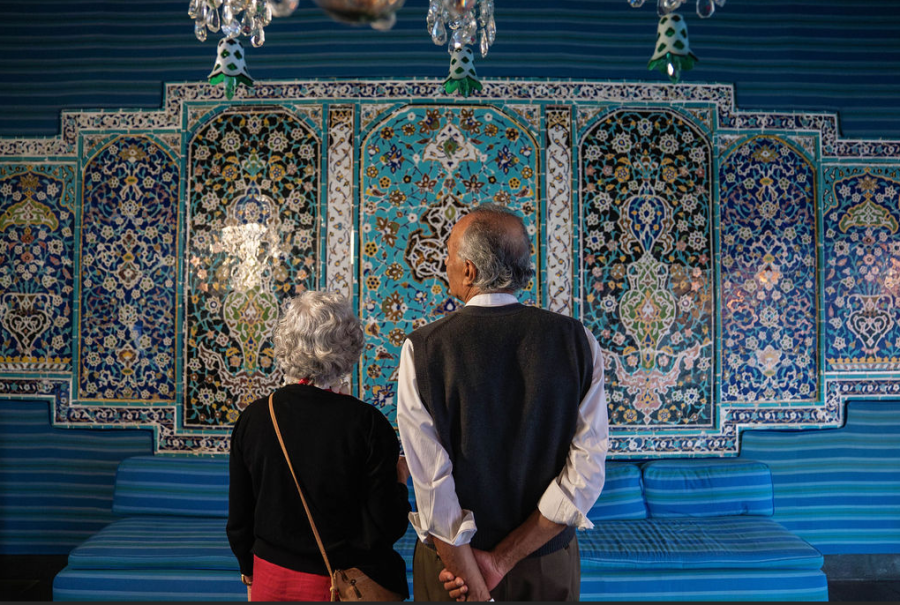HONOLULU (KHON2) — The Shangri La Museum of Islamic Art, Culture and Design is creating new opportunities for kamaʻāina to indulge in the priceless collection of its founder, Doris Duke, at what was her Kahala residence.
Duke, a socialite and heiress from the early 20th century, found a fascination in Islamic art as she traveled the world, using her home for her private collection, which turned into the museum following her death.
“Doris Duke founded Shangri La as a home for her Islamic art collection, 4,500 objects that she collected from her travels and in all different sorts of means through her life,” Shangri La Executive Director Ben Weitz said. “Her original intent was to create Shangri La in Florida, but on her way back from Japan, she stopped in Hawaiʻi with her husband at the time, James Cromwell.”
The beach near Shangri La is known as Cromwell’s, but Weitz emphasized the usage of traditional ʻŌlelo Hawaiʻi names as part of the Shangri La’s mission to preserve culture — not just Islamic culture, but Hawaiian culture as well.
“We like to remind everyone [the beach] is Kaʻalawai,” Weitz said. “We appreciate the importance of place… we find there’s great kuleana in being able to steward this ʻāina, this land, because what an amazing place to have important or maybe difficult conversations.”
Shangri La honors its Hawaiian host culture through regular events and exhibits, such as the He Aka exhibit that is in the museum until February 2026. He Aka highlights local Kānaka Maoli artists, with pieces looking to honor ancestral wisdom.
In addition to He Aka, visitors can view the bountiful amount of art pieces, which include pots, fine china, glasswork, drawings, furniture and more.
Pieces in the collection date back hundreds of years, which Duke acquired through various methods of purchase. There are also items Duke commissioned for herself from various sources, with pieces in her collection tracing back to Syria, Iran, India, Indonesia and many other countries.
One of the crown jewels of the Shangri La is their mihrab, or Islamic prayer wall. Traditionally, a mihrab would be on a wall facing the direction of Mecca, to denote which direction to pray toward according to the Islamic faith.
Duke, who was not Muslim herself, acquired the mihrab out of fascination with the culture. The mihrab at Shangri La is one of the most complete, if not the most complete, artifact of its kind in the world and dates back to the 13th century.
“[Duke] didn’t really leave us too many reasons why it really was so important for her to have the mihrab acquired or have it a part of Shangri La,” Weitz said. “But what we know is that she absolutely cared for preserving it and education audiences about Islamic art. It was very clear in her will that leaving her wealth to a foundation, now called the Doris Duke Foundation, was something she didn’t have to do, but something that she was inspired to do.”
Today’s Shangri La team looks to carry on that legacy of education with expanded visitation opportunities for kamaʻāina on Oʻahu and neighbor islands.
Prior to September 2025, visits to the Shangri La were only done out of the Honolulu Museum of Art. Due to the museum’s unique existence as a residential home, the museum is in a neighborhood. In order to respect those that live next to the Shangri La, guests are not allowed to park on or near the property.
Guests had to take a shuttle from the Honolulu Museum of Art to the Shangri La, where they would be able to participate in the hour-and-a-half tour around the estate. Upon completion, guests could shuttle back to be on their merry way.
But the Shangri La launched a new tour origin in collaboration with the Bishop Museum in September. Now guests can take a shuttle from the Bishop Museum to the Kahala estate to tour the collection.
Tours can be done on Thursdays or Fridays from the Honolulu Museum of Art for $20 and on Saturdays from the Bishop Museum for $25.
Those rates are exclusive, new kamaʻāina rates. Non-residents will have to pay $45 for either tour.
Tickets for the tours used to be released quarterly, but now tickets are available on the first Thursday of the month for the following month, allowing for easier planning rather than organizing your trip three months out.
Shangri La is also working to educate communities outside of Kahala, with the museum organizing temporary exhibits and events outside of their usual confines.
In September, the museum collaborated with the City and County of Honolulu to put up a free temporary exhibit at Honolulu Hale.
Additionally, Weitz teased some potential upcoming events even further away from Kahala.
“We’re trying to show up in unexpected places like Honolulu Hale, maybe we can end up at the MACC on Maui,” he said. “We’d love to be in Waimea on Hawaiʻi Island soon… and I can’t announce anything now, but even on the west side, we have something that’s in the works.”
In addition to the expansions-in-progress, the best way to stay up-to-date with Shangri La’s news and updates is to follow them on social media, Weitz said.
The Shangri La’s website contains digital exhibits as well, furthering access to their art pieces, as well as ticketing information.












